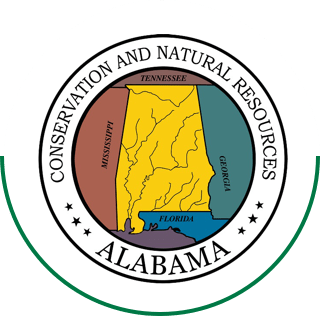Conservation
Gulf State Park Initiatives
We conduct a variety of conservation projects around the Park. With a variety of ecosystems, it is important that we promote healthy and thriving habitats.
Dune Restoration
With the possibility of damaging storms and hurricanes every year, our most important natural protector is the coastal dunes. These hills of sand and shrub act as a barrier against wind and water and literally absorb the impact of threatening weather. We do not allow foot traffic in the dunes; any path we forge for ourselves, is a path that storm surge can follow leading to hazardous road and structural flooding. To encourage dune growth, we have an annual Christmas Tree recycling program. After the holiday, we ask for people to donate their live trees to the Park. Then, we take these trees onto the beach and place them along the edge of the dunes in groups of three, with each group in a 'U' shape. The sand that is naturally carried by wind across the beach will catch in the trees and slowly build up, creating a new area of dune growth. The following spring, Park staff, along with local volunteers, plant native dune plants around the Christmas trees. This incredible restoration program has been happening at the Park for almost four decades!
Prescribed Burning
Most of the ecosystems in Gulf State Park are naturally dependent on fire in order fro them to remain healthy and balanced. To incorporate this natural phenomenon while keeping our local communities safe, the Park conducts prescribed burning of specified areas a few times a year. These burns are planned many months in advance and the burn only takes place on days that are satisfactory for burning. Weather plays a big part in determining exactly when the burn will happen.
These burns are very important as many species of flora and fauna depend on fire. For example, Longleaf Pine trees and the carnivorous Pitcher plants both drop seeds that will only germinate after the heat of fire prompts them to. This is because fire creates an optimal growth environment by enhancing soil nutrient levels and clearing understory growth, allowing sunlight to the plants. Wildlife, such as the protected Gopher Tortoise and Red-Cockaded Woodpecker, depend on fire in their habitats every few years to reduce overgrowth and clear areas for the best foraging. Prescribed burning also significantly lowers the risk of wildfires. By burning through the overgrowth every few years and reducing the amount of 'fuel', the Park is less likely to have a catastrophic wildfire. Though a burned area may not look pretty right away, the following year allows for new growth and increased diversity in plants and animals!
Alabama Beach Mouse
One of the highly protected species here at Gulf State Park is the endangered Alabama Beach Mouse. This mouse is considered to be an indicator species for our dune health. If we have a thriving population of Beach mice, then the overall health the dune ecosystem will be positive. These mice help increase plant diversity in the dunes by eating seeds and then spreading them through defecation. These nocturnal creatures are also an important source of food for many native species of snakes and birds that hunt in the dunes. Throughout the year, biologists set live traps in the dunes to capture the mice, collect important data such weight and gender, and then release them. This data will help determine overall population health and trends. You can help protect the endangered Alabama Beach Mouse by staying out of the dunes and respecting their habitat.
Partnerships
At Gulf State Park we sponsor and support many conservation efforts. As a part of our mission statement, we serve to restore and protect the natural areas of the Park. There are many exciting programs that partner with the Park to help protect sea turtles, nesting shorebirds, the endangered AL Beach Mouse, and more!
Share the Beach - Alabama's Sea Turtle Conservation Program
This volunteer-based program monitors and protects sea turtles and the nests they lay on our beaches! Volunteers patrol the beaches every morning to locate sea turtle nests laid the night before. Then, stakes and rope are used to make a small perimeter around each nest so that beach goers do not disturb it. Volunteers monitor nests through the summer and will monitor and protect the baby sea turtles from human disturbance as they make their way into the Gulf.
To learn more about the important program, visit the Share the Beach website.
Alabama Audubon
Audubon has been conducting essential bird conservation work for decades here in Alabama. The initiatives of this organization are statewide and encompass a variety of species. There are many volunteer opportunities with this organization throughout the year. Visit the Alabama Audubon website for more information.
Alabama Coastal Cleanup
Every year, on one Saturday in September, volunteers meet across the coast to get the trash out of the splash! This huge day of cleanup has been hosted for over 30 years now. At Gulf State Park, we host this cleanup at our Beach Pavilion. Visit the Alabama Coastal Cleanup website to get involved.



